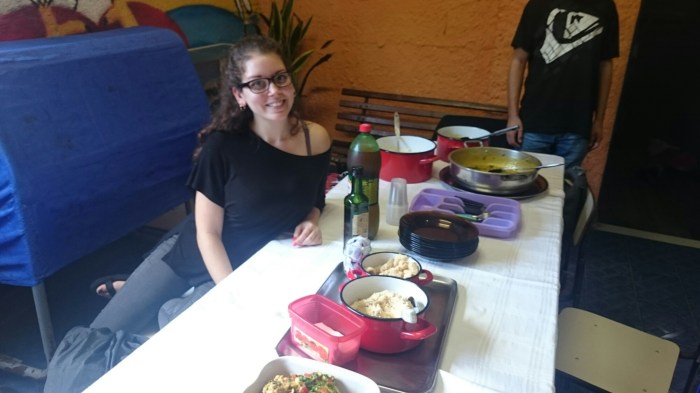Today was a dramatic day that put our intrepid name to the test.
It started dramatically when we awoke to the sound of a loud firework being released near our apartment. We later learned this is a prelude to a police raid of a favela, and soon after we were deafened by the noise of a helicopter circling just outside our window.
But after all this is Rio, favelas are a part of life here and are where many people call home.
Thinking little of it we then, in desperation at the bad weather, signed up for a cookery class in a favela. We didn’t realise we would be going close to home.
We joined the group and soon found ourselves back on our street, but in what we realised was the entrance to the favela, a constructed walkway with a lift up to its lofty position. In all fairness, they have the best view in the city.
At the gateway into the favela were three police with machine guns. It was at this point we all (guide included) had some second thoughts. We discussed and thought it over, and decided to go for it. It was an uncomfortable fifteen or so minutes walking swiftly through the tense favela. We walked through narrow winding alleys, with loose rubble and rubbish strewn everywhere, and people anxiously peering at us through their open living quarters, we could tell it was not a good time.
But we were pleased to find when we arrived that we’d made the right decision. We met the lovely Tia Maria (no joke), a lady from Minas originally who loved to cook so much she worked bringing people all over the city hot meals. She had 26 children, many adopted along the way. She knew what she was doing in the kitchen too.
Here’s what she taught us:
Traditional mocequa:
1. Marinate firm white fish fillets overnight in a mixture of lime (lots of), garlic, chopped parsley, cumin, and chopped coriander.
2. The next day pour out the marinade into a separate bowl, add small brown shrimp, more lime, palm oil (this is what gives it it’s distinctive yellow colour), coconut milk, chopped peppers, chopped fresh tomatoes and parsley.
3. Cook on high heat for 20 mins.
4. Remove the fish and some of the sauce and set aside, and with the remaining sauce in the pan make pirão by placing the pan back on the heat and slowly adding mandioca flour. (This is a thick glutinous sauce commonly served with fish in Brasil).
5. Serve with white rice and feijao branco prepared with vegetables; carrot, maxixe (a type of spiky courgette) and sausage.
6. It was also served with farofa which she had made by frying onions and bacon in oil, adding mandioca flour, cracking in 3 eggs and mixing thoroughly until it is a fine flour. She also added finely ground ‘torresmo’ (crackling) for extra flavour.
Simple and delicious food in Brasil can be found anywhere, you just need to know where to look.
For details on the tour we took or any of the recipes just send us a message.




One Comment on “Rio de Janeiro: Favela cooking”